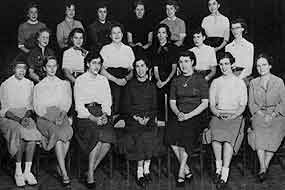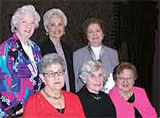
The sounds of Benny Goodman drifted through the auditorium as dozens of nervous young men fidgeted in line, waiting their turn to dance. When it came, they held their partners stiffly, looking down at their feet and mentally reviewing the steps they had just learned during the group lesson. One, two, three, four, one, two, three, four.
At the end of the lesson, a few of the more outgoing men hung around to talk to their female instructors—actually fellow students—about the dance steps, their plans for the weekend ... and whether they knew the answers to that week’s chemistry homework.
A Lasting Bond
This spring, six IIT alumnae from the 1940s and 1950s met for lunch at the University Club in downtown Chicago. Arriving separately, they recognized one another immediately and greeted each other warmly. To an outside observer watching the lively conversation and easy laughter, they appeared to be good friends catching up. And yet the paths of most of these women did not cross in the years after they left IIT. On this May afternoon, however, Karin Turnquist, Marie Ekvall, Rosette Backas, Alice Koplan, Millie Delahunty, and Jeanette Metzdorf celebrated the alumnae bond that still joins them after more than 50 years. That distinction is an especially powerful one for emeritus alumnae (those who graduated before 1955), as they were outnumbered by male students by as much as 33 to 1. “You were very aware of the other women on campus,” said Delahunty. Backas added, “It was very hard to be inconspicuous.” Turnquist had a particularly memorable experience of the ‘fishbowl’ environment on campus. “I changed my outfit at a fraternity house dance and accidentally left it there and it was later written up in the school newspaper,” she laughed.

Few but Mighty
Although their presence on campus was visibly noticeable, making their voices heard took a little more work, a challenge the women did not shy away from. Walking into a physical education class, which was at that time a required course, Delahunty and her female classmates were told that there was no programming or facilities in place for women.
“The instructor threw up his hands and said to us, ‘Why don’t you just do whatever you want?’” said Delahunty. The women would indeed do just that: “Being the agitators we were, we worked on the administration until we got a part-time female physical education instructor and had part of the locker room partitioned off for us,” said Delahunty. “We didn’t take no for an answer,” added Kopan.
While these women advocated for physical amenities on campus, they also worked hard to change the perceptions of those around them. “Going into such a male-dominated college, there was an attitude that we were going to get our ‘MRS’ degrees,” said Delahunty.
If that was the initial opinion held by fellow students and faculty, however, the women quickly reversed it by excelling academically. “I remember my first chemistry class,” said Delahunty. “The instructor said, ‘Look to your right and to your left. Two of you won’t be here next year. And it was true. And the ones who weren’t there were men.”
This strong intellect and determination to succeed academically presented a minor social conflict for women at that time. “If I was dating someone and I earned a higher grade than he did, I noticed a change in his behavior,” said Kopan. “After awhile I just decided to keep my mouth shut.” From the nods her comments elicited around the lunch table, it’s clear that it wasn’t uncommon for IIT women to find themselves in that situation.
While the men on campus may not have been receptive to women competing with them academically, they did allow the women to help them sharpen their social skills.
“We taught the engineers how to dance,” Delahunty recollected. “We lined them up in the auditorium and taught them the steps to the fox trot and the waltz, then took each of them around the hall once.” Laughing, she added, “We considered it a public service.”

A Foundation for Success
With the exception of Turnquist, who graduated with a degree in biology, and Metzdorf, who received a degree in arts and sciences, the other four alumnae studied home economics—a popular academic path for women at that time. While the phrase ‘home economics’ may conjure images of Martha Stewart home improvement projects, IIT’s program was not for anyone lacking left-brain skills.
“Some of the home economics programs at other schools didn’t even have laboratory courses. At IIT we had four years of labs, including chemistry, physics, and bacteriology,” said Ekvall. That background led Ekvall to a successful 25-year career with the U.S. Food and Drug Administration. “At the FDA, you work with all kinds of nutrition, medicines, and radiation. I had to have that strong science background.” Along with the rigorous curriculum, the women identify IIT’s focus on critical thinking as an important part of their education. “Regardless of the discipline, IIT taught us critical thinking skills that have benefited us throughout our careers and our lives,” said Kopan.
The business courses included in IIT’s home economics curriculum also provided the women with tools for success in the workplace, including Delahunty, whose job immediately after college entailed covering a tri-state sales area. “Having worked and studied and negotiated with men for four years at IIT, I was in good shape to work with them when I graduated,” Delahunty said.
Exposure to a multitude of disciplines, including business, science, and economics, led these women to develop some particularly innovative ideas. “At one time, a group of us sat out on the lawn developing a plan for a shopping mall,” said Kopan. Although the idea didn’t materialize as the women went their separate ways, they realized what a revolutionary concept they had created when the first enclosed shopping mall in the United States opened its doors a few years later.
Looking to the Future
Reminiscing about their own experiences as students, the women were excited to learn that the male-to-female student ratio at IIT is no longer 33 to 1, but 3 to 1, and to hear that women are better represented across all disciplines. Metzdorf, a member of IIT’s first graduating class of 1941 after the merger of Armour College and Lewis Institute, has noticed the diversity in her sorority contemporaries. “Many of my young Kappa Phi Delta cohorts now are engineers and architects,” she said.
The energy around the dining table was palpable as the afternoon progressed and the six alumnae discussed the importance of capturing the history of women at IIT. “I think there are a lot of wonderful success stories that need to be told,” said Ekvall.
As they chatted about ways to reengage IIT alumnae, it wasn’t hard for an outside observer to imagine them as they must have been years ago firmly arguing with administrators over the need for a physical education instructor, confidently directing engineers in the art of the fox trot, and channeling their determination, energy, and skills into successful career and community endeavors.
“I hope today’s gathering serves as a springboard to greater things,” said Kopan as the women said their good-byes. If their tales of perseverance and ingenuity are any indication, there’s no doubt that that hope will soon become a reality.
Are you an IIT alumna who would like to reconnect with fellow alumnae? Please join us for a special fall program on IIT’s Main Campus that will include a campus tour, an overview of IIT’s academic initiatives, and a special presentation about IIT women. For details, contact Kate Chappell at 312.567.6928 or chappell@iit.edu.
Alumnae of the ’40s and ’50s: Then and Now
Although the concept of ‘interprofessionalism’ didn’t formally make its way into IIT’s curriculum until the 1990s, all alumnae of the 1940s and 1950s, regardless of their majors, benefited from an education that combined their core curriculum with business and science fundamentals. As a result, these six alumnae with degrees in home economics, biology, and arts and sciences have parlayed their rich education into an impressive array of career experiences.

Karin Turnquist (BIOL ’53)
worked as a research and development chemist, then served as head of a quality control lab. She did consulting work and later in life became a tax preparer for H&R Block. She also received an associate nursing degree from Triton College.

Alice Kopan (HE ’53)
has spent her career as an educational administrator and consultant. She has authored textbooks for industry and academia and has worked as an urban educator, a journalist, and a supervisor of student teachers at various colleges. She served as a city supervisor for the Chicago Public Schools and was a North Central Association accreditation coordinator.

Marie Ekvall (HE ’52)
worked for Quaker Oats in laboratory research, developed and wrote about recipes for a cookbook publishing company, and was assistant food editor for Chicago’s American magazine. She spent the last 25 years of her career as director of consumer affairs for the U.S. Food and Drug Administration, working to integrate FDA subject matter into high school, college, and professional curricula, and developing consumer education and media relations programs.

Millie Delahunty (HE ’53)
is president of Microwave Cuisine, a consultancy she started in 1981 that specializes in microwave cooking communication and education. She has been published in Cooking Light magazine and is the author of six microwave cookbooks and three texts on teaching microwave cooking.

Rosette Backas (HE ’52)
was a high school home economics teacher for 27 years. After her teaching career, she held a variety of freelance positions for such companies as Swift & Company and OPTIFAST.

Jeanette Metzdorf (ARSC ’41)
worked for Commonwealth Edison and G.E. Supply in customer relations, with a focus on electrical equipment and appliances. She also worked for IIT’s Alumni Relations and Admission departments, and spent the latter part of her career doing marketing work for the Poultry and Egg National Board.